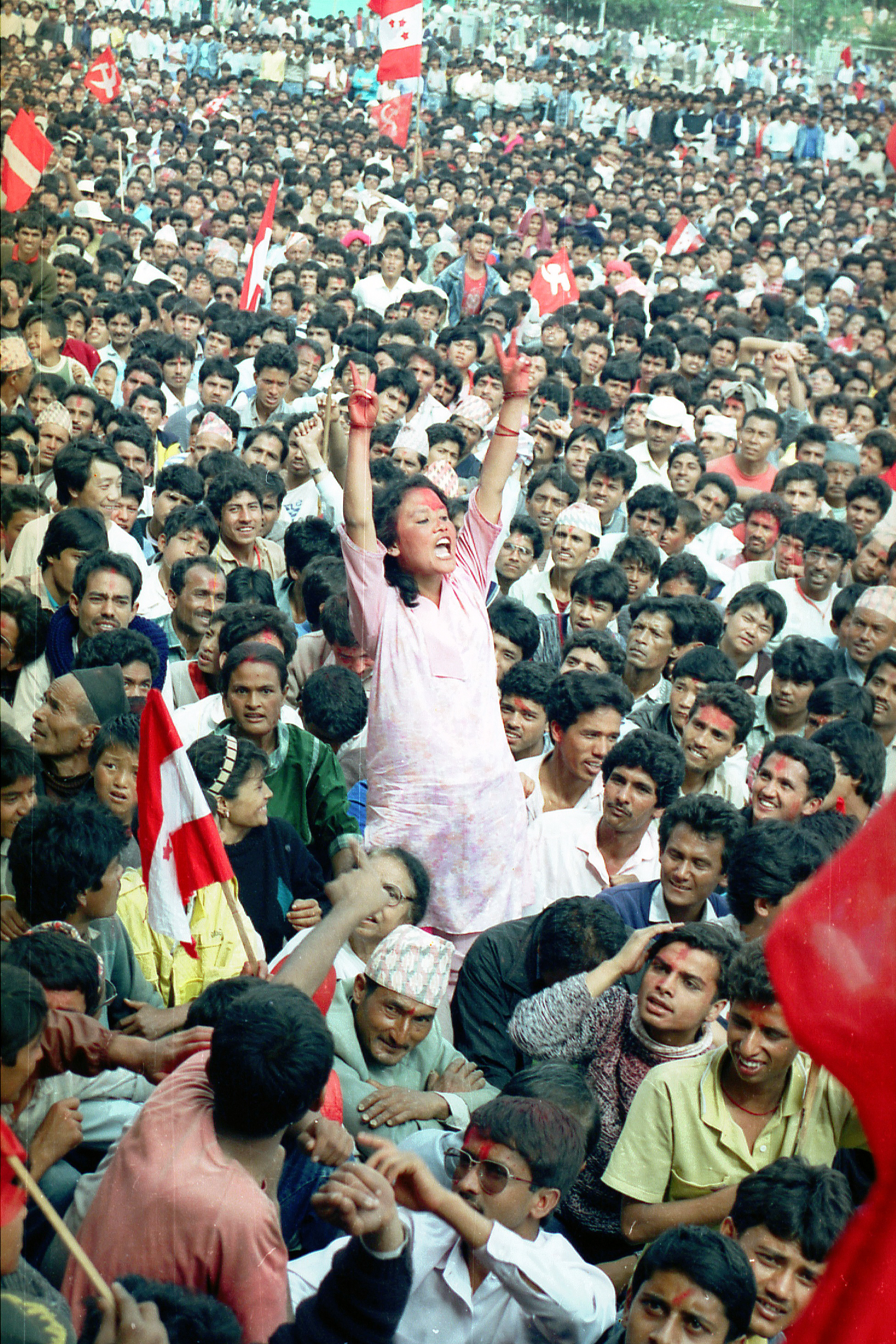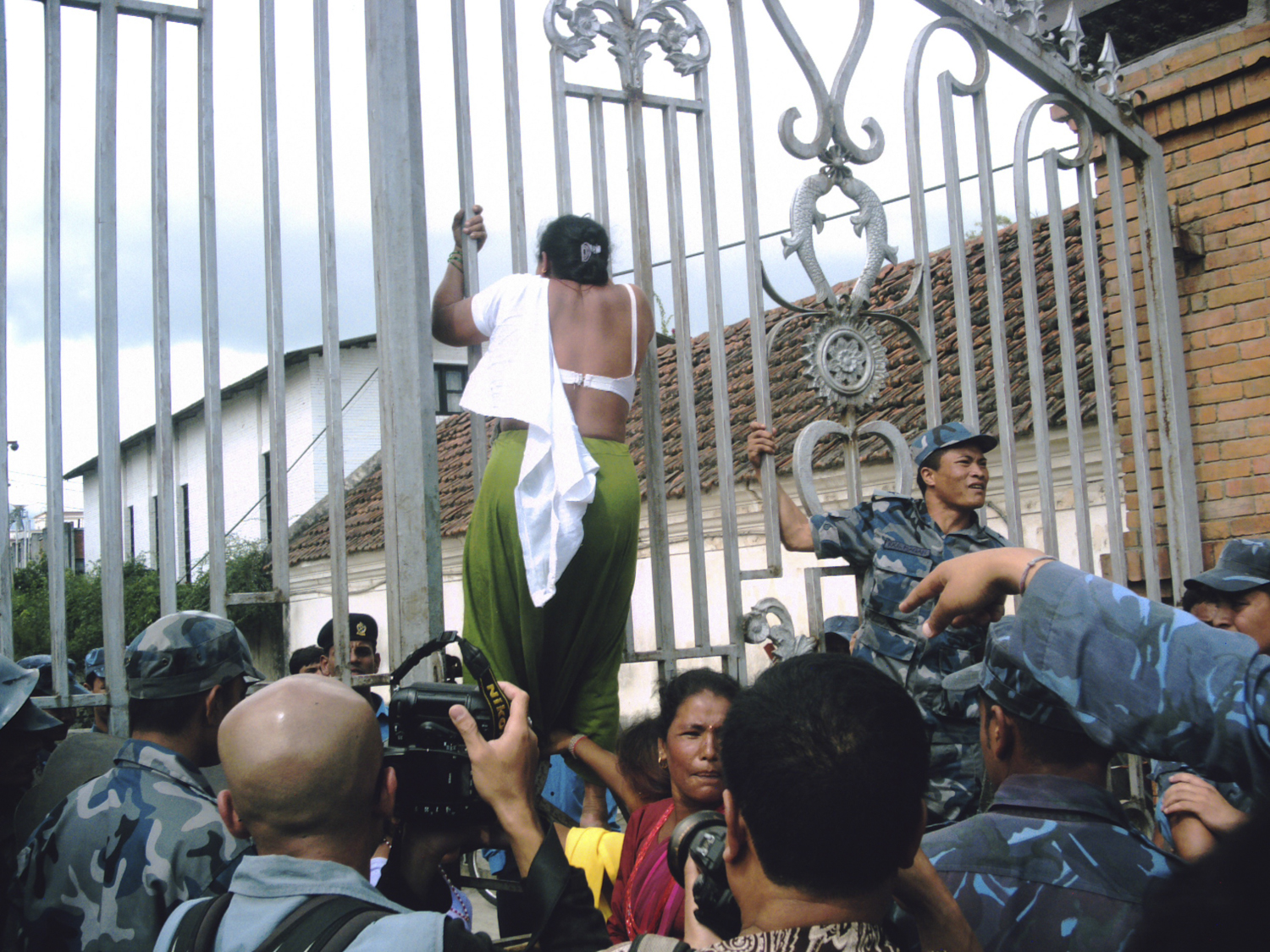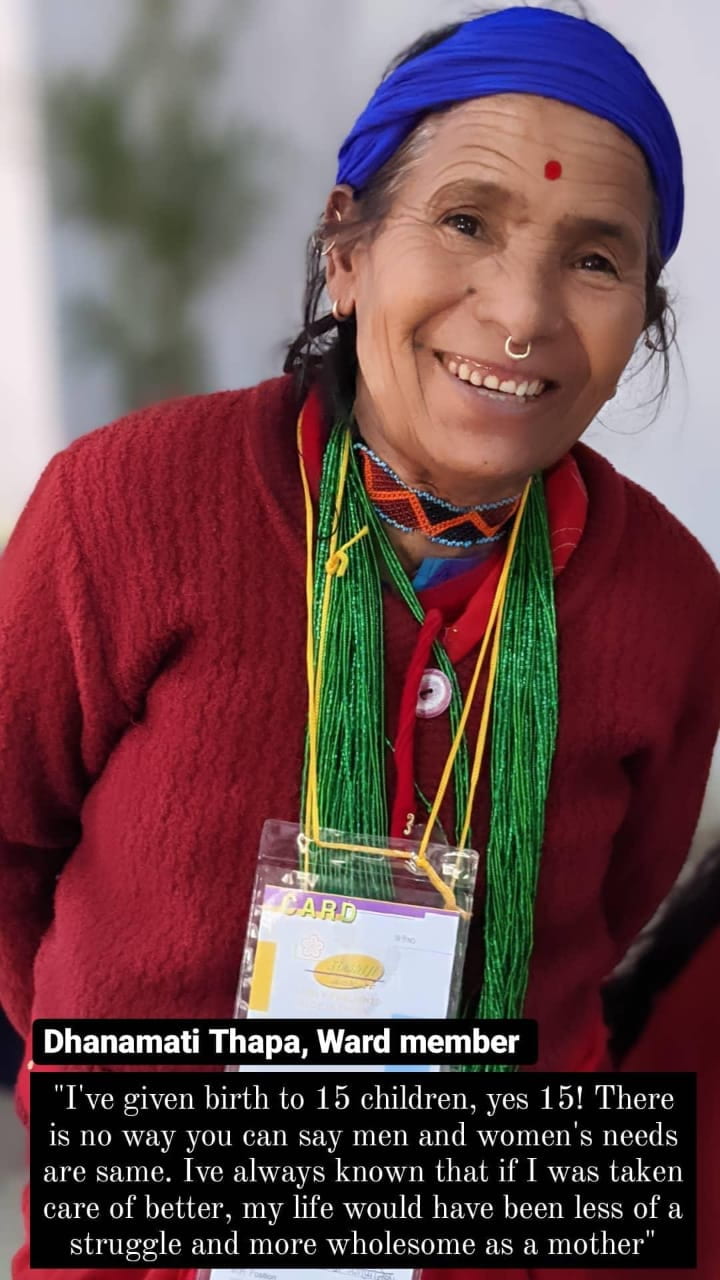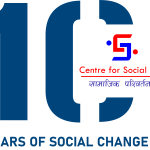
Women’s nonviolent participation in social justice and freedom struggle in Nepal
Min Bajracharya’s iconic photograph of Durga Thapa, 22, as she leapt up during a victory rally on 9 April 1990 to shout “Long live democracy!”
Author: Prashamsha Simkhada
In what has now become an iconic picture of the People’s Movement of 1990 in Nepal, a struggle to restore democracy, a 22-year old Durga Thapa is seen smeared in vermillion, triumphing with a victory sign amidst a huge crowd. This picture by Min Bajracharya speaks volumes about Nepali women and their involvement in various movements of Nepal.

History
Nepali women have always been an inseparable part of the nonviolent social movements in Nepal. Whether it be in the 1950s when women fought against the autocratic Rana oligarchy, or at present, when women are demanding equal citizenship rights, women across castes and ethnicities have led and are currently leading the fight for equality and rights for Nepali women.
One of the earliest leaders of a movement in Nepal was an elderly female ascetic Yogmaya Neupane who advocated for Dharmarajya (a religious state) and an end to discriminatory practices against women such as forbidding women’s education, remarriage of child widows and polygamy. She also advocated for democracy during the Rana regime in the 1940s. Women’s participation in the 1950s movement in Nepal to overthrow the autocratic Rana rulers and establish democracy and in the 1990 People’s Movement to reinstate multiparty democracy were both significant.
Mangla Devi Singh, for instance, was a prominent democratic rights activist who fought for the civil rights of women throughout her life. Similarly Heera Devi Yami founded the first women’s association of Nepal. Sahana Pradhan and Shailaja Acharya, prominent female politicians of Nepal, not only led successful political careers but they were also heavily involved with the feminist movement of Nepal.
Women stood alongside men and led the second people’s movement and successfully ensured 33 percent representation of women in politics. Other significant achievements that should not be left out of discussion is the role of women in various social and political movements led by Dalits, Janajatis, Madhesis and Maoists which culminated in substantial changes at an institutional level and policy level including affirmative action in form of reservations to women in many sectors including civil service, education and mainstreaming of gender and social inclusion in development plans of Nepal.
Present Context
At present many women’s rights groups continue to actively lead the agenda of rights of women and gender justice through collective efforts of individuals leaders and civil society organizations in Nepal. Uma Devi Badi, a leader of the Badi movement, a movement to end untouchability, prostitution-based forced labor and landlessness of Badi community of Nepal, is an example. Another example is Durga Sob, a human rights activist and feminist who is leading the movement against caste-based discrimination. Likewise Mohana Ansari, Anuradha Koirala and Chari Maya Tamang are pioneer women rights and human activists in Nepal who have fought hard for human rights of women and against trafficking of girls in Nepal. These women have devoted their lifetime and continue to work for women’s rights. Nepali women are in a much better situation than before due to various nonviolent social movements led by female activists.

Challenges
Despite the continuous efforts and successes women-led social movements have not resulted in lasting impact. One of the recent social movements Occupy Baluwatar of December 2012 is a testament to this fact. This campaign which lasted for 107 days was initiated by individual campaigners that evolved into a full-fledged campaign to fight violence against women and impunity. The campaign garnered widespread support from the public, leading women rights activists, civil society members and political parties. But the campaign frizzled out afterwards making only minimal impact. The campaign highlighted the division among the human rights and women rights community. Their divergent opinions on women’s rights as a cross cutting issue and separate issue ultimately hampered the success of the movement. Another problem that Seira Tamanag (2008) attributes to the feminist movement of Nepal is how it has failed to incorporate issues of the marginalized within the women’s movement by pushing forward a single feminist agenda against the diversity of Nepali women. She accuses Nepali women’s movement of being elitist that dismisses the voice of the marginalized and thereby fails to garner the force. So, there is a need to reflect on the intersectionality of Nepali women and acknowledge the multifaceted needs of all Nepali women.
Opportunity
The use of social media platforms is on the rise within global as well as Nepali social movement scene. The Occupy Baluwatar campaign also first utilized social media and #Occupybaluwatar was one of the trending hashtags on Twitter and Facebook throughout the movement. An ever-increasing internet penetration and easy access to social media ensures Nepali women collectively have a stronger voice. To give an example, women are actively leading a nonviolent movement against rape through hashtags on Twitter and Facebook such as #Rageagainstrape. Amidst increasing rape cases youth activists also raised successful nonviolent campaigns through flashmob and social media. Prakriti Bhattrai Basnet, one of the activists who led the peaceful #Ajhaikatisahane (translates ‘how much shall we tolerate’) campaign in the middle of pandemic, also runs Political Literacy for Women which promotes inclusivity in politics. Her flash mob titled “Balatkari hos ta..(You are a rapist)” drew widespread media attention and accolades from the public.
A closer inspection of innovation in women-led social movements goes as far as 2004 when a group of women called Charitraheen Cheli issued a 40-point declaration manifesto through an anonymous email id and declared war against patriarchy. They subsequently laid groundwork for activism on issues which are relevant even after decades. Now women are uniting in social media to openly discuss the discrimination they face on a daily basis. Tales of a modern bhuhari, an anonymous Instagram account, is challenging societal norms on how married Nepali women should be. This Instagram page, with tens of thousands of Nepali women as its followers, has provided a safe space for Nepali married women to voice the discrimination they face every day and demand change. Even so we cannot undermine offline grassroot campaigns and social movements.
Although social media can be a powerful tool to fight against discrimination through the use of compelling hashtags and captions, it is also equally important to give momentum to grassroot social movements. The Period hut (Chaupadi) abolition movements, for instance, was possible due to empowerment of women in the area by various civil society organizations. Besides, a criticism faced by social media activism is that it does not seem to produce lasting impact and only few such campaigns manage to sustain for a long period. Since Occupy Baluwatar, new social media-led movements have emerged but they too have been short lived. Nonetheless social media is still an important platform for Nepali women. It is one of the most accessible platforms to have a say.
Way Forward
Regardless, the discrimination and inequality faced by women persists. The case of Rupa Sunar who called out against caste-based discrimination faced by Dalits and sparked a nationwide discussion on violence against Dalits is a case in point. Therefore, another challenge for the women led nonviolent movement in Nepal is also to lend a voice to marginalized women from all across Nepal as well as to ensure their participation. It is high time to move the discourse beyond homogenized Nepali women and finally recognize the diversity of Nepali women and the disparate forms of discriminations on the grounds of caste, ethnicity and religion. Furthermore, it is high time the women’s movement of Nepal shed off its elitist and urban centric image and led the way for an inclusive movement in actuality.
The other challenge for the women’s movement is to ensure the representation of women without access to technology. The onus lies on the urban Nepali women to bridge the gap in technology between them and their compatriots in rural villages. For instance, Preet Shah from Kathmandu recently wrote a blog on Global Women’s Institute about the grassroots movement of women from rural far west Nepal for their political engagement and literacy. In urban areas social media has been instrumental in bringing the nonviolent movements into limelight. But the struggles and successes of similar nonviolent movements from rural Nepal also need acknowledgement. In a globalized world, as predominantly urban Nepali women stand in solidarity with women across the globe with hashtags such as #metoo, the voices of women from the rural hinterlands of Nepal and their genuine cause and fight for rights should not be drowned out.

The graphics, views and opinions expressed in the piece above are solely those of the original author(s) and contributor(s). They do not necessarily represent the views of Centre for Social Change.

Ms. Prashamsha Simkhada holds MA in Conflict, Peace, and Development Studies from Tribhuvan University. She has around five years of experience in the development sector in Nepal.
©2021 Centre for Social Change, Kathmandu
